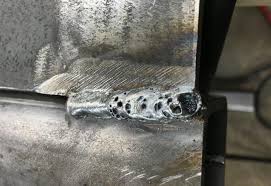What is Porosity in Welding: Comprehending Its Causes and Enhancing Your Skills
Wiki Article
Porosity in Welding: Identifying Common Issues and Implementing Finest Practices for Avoidance
Porosity in welding is a prevalent concern that commonly goes unnoticed up until it creates substantial troubles with the integrity of welds. In this conversation, we will discover the crucial elements adding to porosity formation, analyze its damaging effects on weld efficiency, and talk about the best techniques that can be adopted to reduce porosity event in welding processes.Usual Reasons For Porosity

One more frequent culprit behind porosity is the existence of pollutants on the surface of the base metal, such as oil, grease, or rust. When these contaminants are not effectively removed before welding, they can evaporate and come to be entraped in the weld, creating flaws. Moreover, making use of dirty or damp filler products can introduce impurities into the weld, contributing to porosity problems. To minimize these common sources of porosity, extensive cleansing of base steels, correct securing gas option, and adherence to optimum welding criteria are essential practices in achieving top quality, porosity-free welds.
Effect of Porosity on Weld Quality

The visibility of porosity in welding can substantially compromise the architectural integrity and mechanical properties of welded joints. Porosity produces gaps within the weld steel, weakening its total strength and load-bearing ability.
One of the key consequences of porosity is a decline in the weld's ductility and durability. Welds with high porosity levels often tend to exhibit reduced influence toughness and lowered capacity to deform plastically before fracturing. This can be specifically concerning in applications where the bonded parts undergo dynamic or cyclic loading conditions. Porosity can restrain the weld's ability to successfully send forces, leading to premature weld failure and navigate here prospective safety and security hazards in vital frameworks. What is Porosity.
Finest Practices for Porosity Prevention
To improve the architectural honesty and top quality of bonded joints, what details actions can be implemented to minimize the occurrence of porosity during the welding procedure? Porosity avoidance in welding is crucial to guarantee the integrity and strength of the final weld. One effective practice is correct cleansing of the base metal, removing any kind of pollutants such as corrosion, oil, paint, or moisture that can result in gas entrapment. Ensuring that the welding tools is in excellent condition, with tidy consumables and appropriate gas circulation rates, can likewise significantly lower porosity. Additionally, keeping a stable arc and controlling the welding parameters, such as voltage, existing, and take a trip speed, aids develop a constant weld pool that minimizes the threat of gas entrapment. Utilizing the right welding technique for the specific product being welded, such as adjusting the welding angle and weapon setting, can even more prevent porosity. Normal assessment of welds and immediate removal of any type of concerns recognized throughout the welding procedure are important practices to stop porosity and create top notch welds.Significance of Correct Welding Techniques
Executing proper welding strategies is paramount in ensuring the architectural honesty and top quality of bonded joints, developing upon the structure of efficient porosity prevention measures. Excessive warmth can lead to raised porosity due to the entrapment of gases in the weld swimming pool. Furthermore, utilizing the suitable welding parameters, such as voltage, current, and take a trip rate, is important for accomplishing sound welds with marginal porosity.In addition, the option of welding process, whether it be MIG, TIG, or stick welding, should straighten with the certain demands of the job to make certain ideal results. Proper cleansing and preparation of the base steel, along with choosing the right filler product, are likewise important parts of efficient welding methods. By adhering to these finest practices, welders can decrease the danger of porosity development and create high-quality, structurally sound welds.

Examining and Quality Control Procedures
website here Checking procedures are necessary to spot and protect against porosity in welding, guaranteeing the toughness and toughness of the final product. Non-destructive screening approaches such as ultrasonic testing, radiographic screening, and aesthetic evaluation are frequently used to identify prospective issues like porosity.Carrying out pre-weld and post-weld assessments go to website is additionally important in preserving quality assurance standards. Pre-weld inspections involve validating the products, tools setups, and cleanliness of the workspace to avoid contamination. Post-weld evaluations, on the various other hand, examine the final weld for any kind of problems, consisting of porosity, and verify that it satisfies specified criteria. Carrying out a detailed top quality control strategy that consists of detailed screening treatments and assessments is extremely important to lowering porosity concerns and making sure the general high quality of welded joints.
Conclusion
To conclude, porosity in welding can be a typical issue that influences the high quality of welds. By identifying the usual root causes of porosity and implementing ideal practices for avoidance, such as proper welding methods and testing procedures, welders can make sure premium quality and dependable welds. It is important to prioritize avoidance techniques to decrease the incident of porosity and keep the stability of bonded structures.Report this wiki page